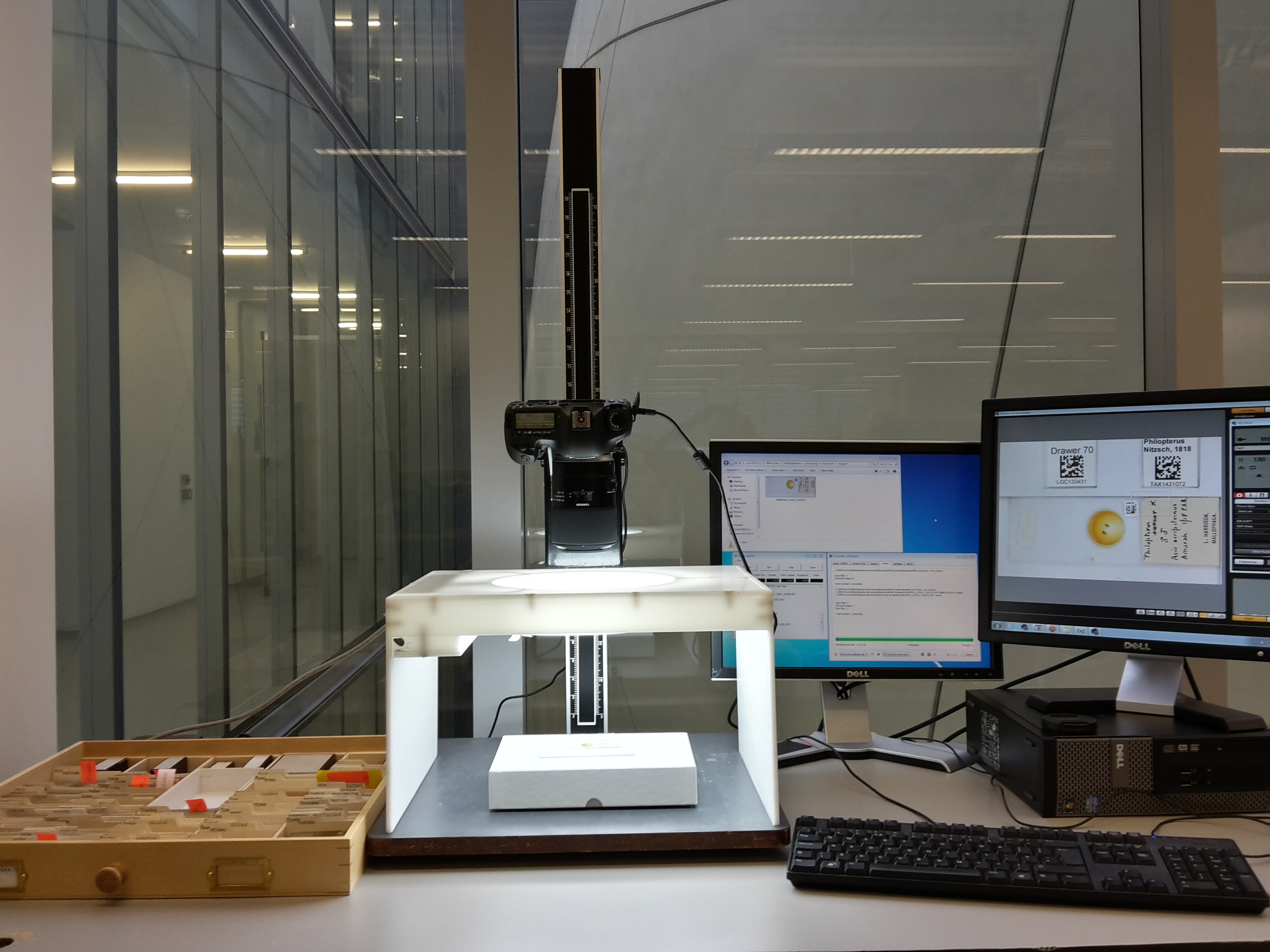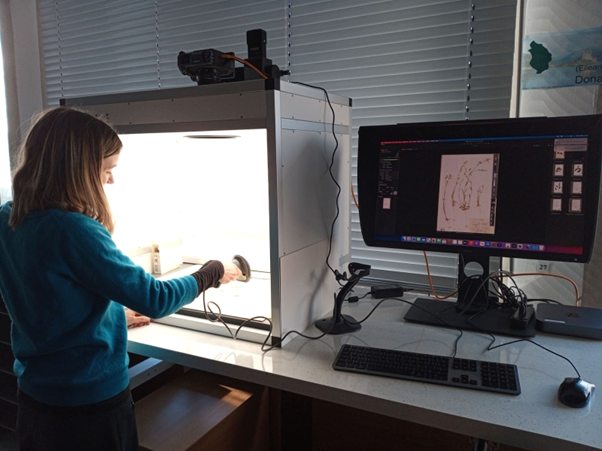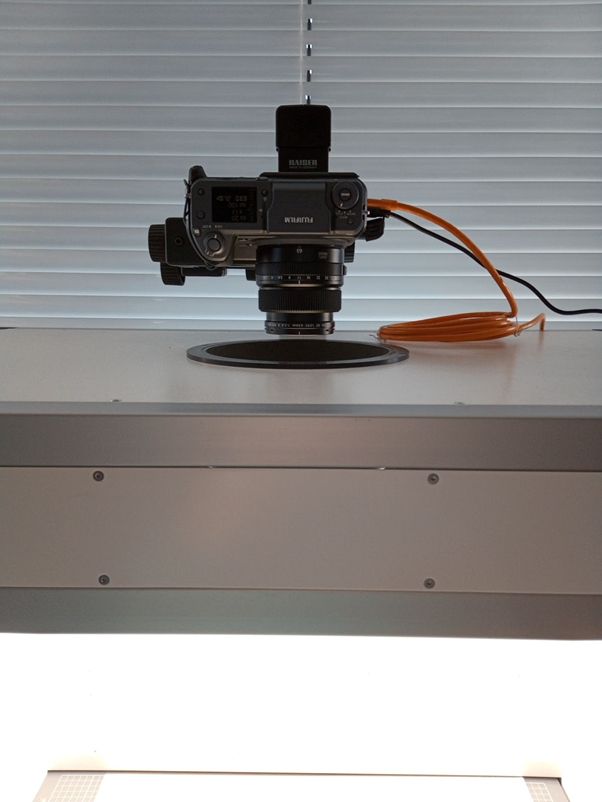Digitisation Stations
Table of contents
Introduction
This page describes the equipment used in digitisation stations at the Natural History Museum, London and Royal Botanic Garden Edinburgh.
We will be adding more guidance about digitisation equipment, including scanners,cameras and barcode readers, so check back soon. Please also see our Software page for more information about the software we use in our digitisation workflows.
Digitisation Station - Natural History Museum, London
The equipment listed below is used in some of the digitisation stations at the Natural History Museum, London (NHM). We have listed the equipment currently used in this setup, although there are others available with similar specifications.
Hardware
The image below shows an example of a digitisation station at the NHM. It includes a camera, stand and lightbox. Specimens are positioned in the lightbox, and images are captured using a button on the computer.

Digitisation Equipment
Kaiser RS1 copy stand
Canon R6
Canon RF 100mm f2.8 L Macro IS USM Lens
Canon DR-E6 DC Coupler
Canon AC-E6N Adapter Kit
Barcode Reader: Code CR950-K301-C500
Lightbox - This is currently custom made at the Natural History Museum, London. Please get in touch with us (dissco-uk@nhm.ac.uk) for more information.
Computer
This is the computer set-up used alongside this digitisation station. See this page for more information about IT infrastructure and data management in digitisation projects.
Core i5 CPU8
GB RAM500GB SSD
24” Monitor
Workflows
This digitisation set-up is used in many of our digitisation projects at the NHM, including:
Microscope Slides
Pinned Insects
This station is being piloted with other institutions within the DiSSCo UK network, and we hope to include more workflows on this site soon.
The table below shows the digitisation rates achieved using this set-up in our microscope slide workflow (Allan et al., 2019).
Table: Estimates of digitised slides per person per day
| Digisiters (focused testing*) | Digitisers(real world) | |
|---|---|---|
| Min (a) | 476 | 370 |
| Max (b) | 1103 | 1006 |
| Median (m) | 741 | 700 |
| Base rate (a+4m+b)/6 | 757 | 696 |
| Standard Deviation (b-a)/6 | 105 | 106 |
| Error Rate | 0.006 |
*focused testing shows the rate when only digitisation activities are occurring, which is unlikely to be achieved in every day work due to meetings and other interuptions
Herbarium Sheet Imaging Station - Royal Botanic Garden Edinburgh
This section describes the equipment for the herbarium sheet imaging station that is used at the Royal Botanic Garden Edinburgh (RBGE).
Hardware
The digitisation stations at RBGE consist of a camera, lightbox and copy stand, which is set up alongside a computer.

Camera Equipment
Following testing of several camera options, RBGE selected a Fujifilm camera that gave a good quality images at a reasonable price. These cameras are being installed in RBGE’s imaging stations in order to standardise the set-up.
- Fujifilm GFX 100 Medium Format camera body: 102 MP, 43.8mm x 32.9mm sensor size. Given that the power adaptor for this camera has been discontinued, the GFX 100S camera body would be an alternative option
- Fujifilm GF 63mm f2.8 R WR Lens
- TetherTools TetherPro USB-C to USB-C 10ft (3m) Orange

Lightbox
RBGE were unable to find a lightbox available that fitted their needs, so they worked with two different suppliers/manufacturers to develop suitable products.
Two options are currently used, both custom built to RBGE specifications:
- Cirro Lite LEDCloud PhotoBox
- Stoane Lighting Bespoke photography light box V2 product number 001826
Copy Stand
The lightboxes have been constructed to fit the Kaiser copy stand.
- Kaiser Copy Base Board with Socket and Adjustable Feet 80x60
- Kaiser Column 1m with Friction Drive
- Kaiser Camera Arm RTX
Adjustable Table
An adjustable table has been an important part of the RBGE imaging stations, enabling the Lightbox and camera to be set at a suitable, ergonomic height for each individual digitiser.
Two options currently being used, both including customised options from existing products:
Colour Targets
The colour target is fixed on the imaging set-up, so dimensions were chosen that would fit the dimensions of the specimen as much as possible.
Computer
RBGE use a Mac computer in their imaging stations - having tried both PCs and Macs, they found a Mac reduced software issues.
-
Mac Mini with either an Intel Core i7 Processor, 32GB RAM or a M1 Processor, 16GB RAM
-
BenQ SW2700PT 27 Inch Monitor or equivalent
Tethering Software
Several options were explored for tethering software to be able to process images captured in RAW format, with CaptureOne now used.
Image Editing Software
Some simple editing software is used to manage specimens that need multiple images e.g. material in capsules: Adobe Photoshop Elements
Workflows
This imaging station is used in the RBGE Herbarium Sheet Mass Digitisation workflow.
Herbarium Sheet Imaging Station - Royal Horticultural Society
The equipment listed here is used by the Royal Horticultural Society in the UK to image their herbarium sheets.
Hardware
Phase 1 XF system camera
XF Waist Level Finder
Credo 80 mm lens LS
Herbscan imaging station with reflective sides and LED illumination
Kaiser Copy Stand with 600 x 800 baseboard and 1000mm column and camera arm
Mac Studio with Studio Display
Authors
Lisa French, Peter Wing, Elspeth Haston, Yvette Harvey, Robyn Drinkwater, Sally King
Natural History Museum, London, Royal Botanic Garden Edinburgh & Royal Horticultural Society

References
Allan, L. E., Price, B.W., Shchedrina, O., Dupont, S., Livermore, L., & Smith, V. S. (2019). Mass-imaging of microscopic and other slides. Zenodo. https://doi.org/10.5281/zenodo.336448
Document Control
Version: 0.5
Changes since last version: Added RBGE Herbarium station (v0.4), Added RHS Herbarium station (v0.5)
Last Updated: 21 April 2023
Edit This Page
You can suggest changes to this page on our GitHub